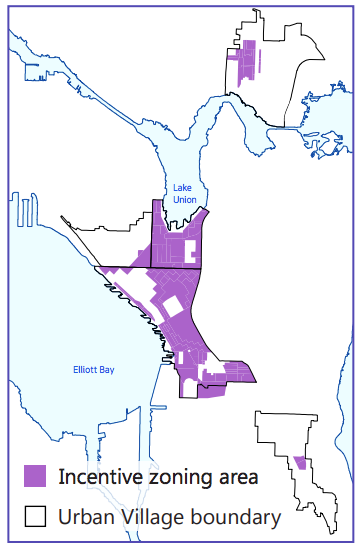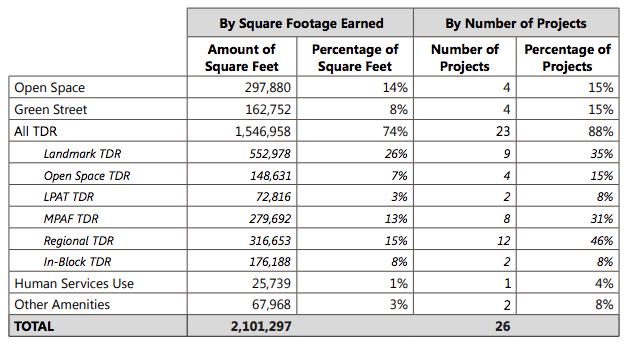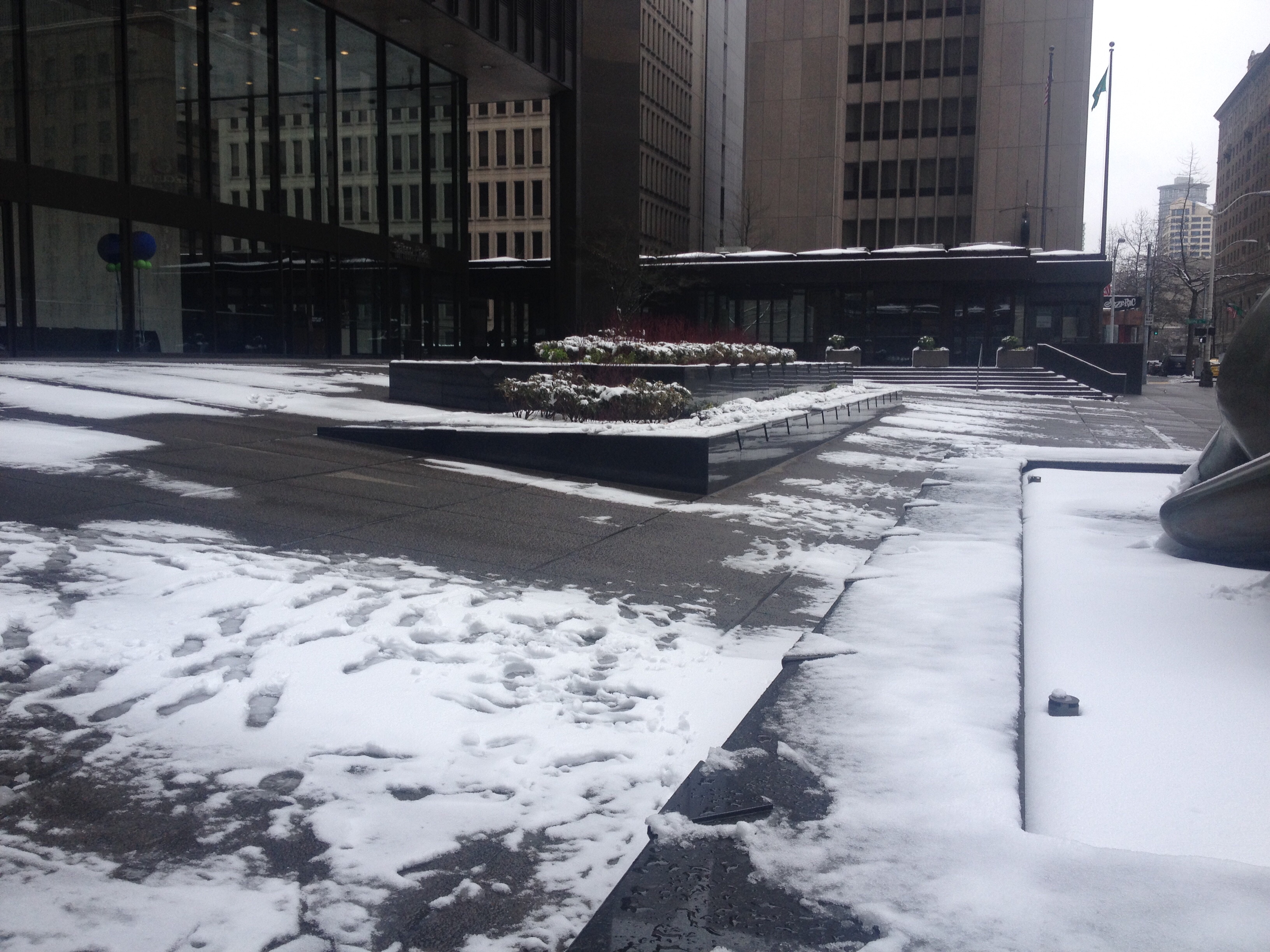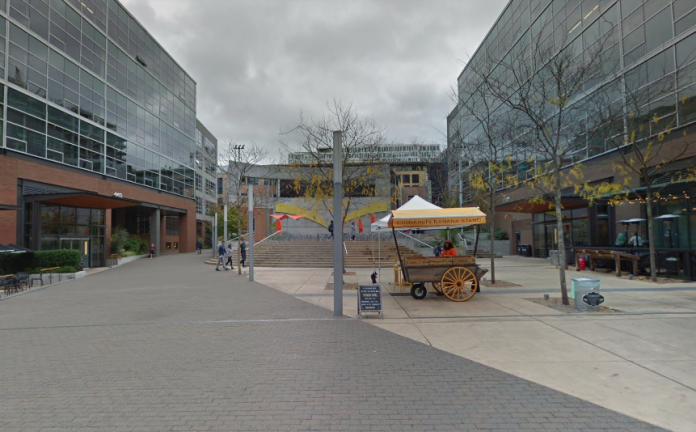Seattle’s incentive zoning program could get much needed tweaks in the next year or so. On Monday, the Office of Planning and Community Development (OPCD) unveiled an initial proposal consisting of more than a dozen objectives for reform. The overarching goal of the changes is to improve how the program operates. Changes will not expand the program to new areas or change overall incentive ratios.

Incentive zoning has operated in Seattle since the 1980s as a way to achieve certain public policy objectives while giving developers options to build more square footage. The first incentive zoning was implemented in the city center, primarily focusing on the central business district and retail core. Wider use of incentive zoning began in 2009 when Chinatown-International District and surrounding areas were added. Now forms of incentive zoning operate in South Lake Union (nearly the entire neighborhood) and portions of the University District, Uptown, and North Rainier.
Typical categories of incentives options include affordable housing contributions, privately-owned public spaces (e.g., plazas, accessible atriums, and hillclimbs assists), childcare facilities, Green Street improvements, and preservation of historic properties, open space, and vulnerable masonry structures through purchase of transfer of development rights (TDRs). Recent changes under the Mandatory Housing Affordability program has partially expanded the scope of some incentive options while also harmonizing them with mandatory requirements for affordable housing contributions.
OPCD’s background report shows that incentive zoning in the city center has been fairly productive. With data back to 2004, the report indicates that 40 projects have used some combination of incentives in the city center, about three projects per year. 14 of those projects fully met their incentive requirements through affordable housing or affordable housing and childcare facility contributions. Through incentive zoning, one development provided childcare space on-site and an additional $14.5 million in contributions was raised for securing more childcare space in the city center. For the other 26 city center projects, OPCD reports that a mixture of incentives have been used:

Meanwhile, 16 projects in South Lake Union have participated in the incentive zoning program generating $3.7 million in childcare facility contributions and preserving 2,000 acres of farmland through purchase of TDRs. Incentive zoning options were expanding for the neighborhood in 2013, so other public benefits could be provided in the future.
In other areas, the program has yet to see the same kind of success. Recent implementation in places like Uptown, North Rainier, and the University District largely explain why there probably hasn’t been any projects built with incentives to date–that is likely to change soon in the University District, however.
What’s Proposed
Perhaps it’s best to start with what isn’t changing, or at least not proposed. OPCD says that incentive zoning is not proposed to be implemented in new geographic areas and the amount of floor area that can be gained through incentives won’t change. However, the following are proposed changes to the incentive zoning program generally:
- For better implementation and usability, OPCD wants to move the incentive zoning provisions to one consolidated chapter of the Land Use Code. Many recent code amendments have put incentive zoning requirements in specific zoning chapters instead of Chapter 23.58A SMC. The consolidation would be paired with modification standards.
- OPCD wants to modify the schedule for childcare payment ($4.55 per square foot of extra floor) and performance (0.000127 of a child care slot per square foot of extra floor) standards to reflect changes in the market. The revised schedule would be based upon a recent study. Several other technical changes could be made with childcare provisions related to hours of operation and off-site performance.

- Right now, the Seattle Department of Construction and Inspections is proposing an overhaul to the city’s green building pilot program. A new option, referred to as the 2030 Challenge High Performance Building Pilot, could be added and encourage the preservation and retrofitting of historic structures with green building techniques. For TDRs related to this, those projects participating in the new pilot program would be eligible to sell additional TDR credits, which is the connection to the overall incentive zoning program changes.
- OPCD is proposing simplification and consolidation of open space incentive options. Several different types exist in the Land Use Code, often creating confusion about objectives and standards. Instead, OPCD wants to establish a consistent urban plaza standard for privately-owned public spaces. The new standard would prescribe a variety of requirements related to site layout, access, landscaping, and seating in addition to hours of public access, lighting, allowed activities, and amenities. (See the full draft of the standards online.)

A major incentive zoning issue that OPCD wants to resolve is TDRs for Downtown zones. To do this, OPCD is proposing simplification of the Transferable Development Potential (TDR) and Transferable Development Potential (TDP) programs by merging them. In simple terms, TDR credits may be used for commercial development while TDP credits may be used for residential development. Even though both credits can derive from sites with historic structures, open space, and vulnerable masonry buildings, their use is limited when sold on the market and not convertible to the opposite form. This makes it hard for sellers and buyers to understand and could be leading to lowered use.
OPCD is considering several other changes to the TDR program, including elimination of geographic constraints to using TDRs and TDPs in the Downtown Urban Center subareas and modifying TDR standards so that they are simpler to implement.
One benefit of the TDR changes could fall on those selling Landmark TDRs by adjusting the calculation method, particularly in the Belltown area and to a lesser extent to properties in South Downtown, by resetting the maximum floor area ratio (FAR) that can be converted from unused square footage on Landmark properties (some zones have no maximum FAR, for instance, while others have very low FAR limits). On balance, OPCD estimates that the proposed calculation changes would increase the amount of possible Landmark TDRs from 5.7 million square feet to 7.0 million square feet.
The remainder of the proposed incentive zoning program changes would be focused on the Downtown Urban Center (inclusive of Pioneer Square and Chinatown-International District):
- Instead of relying on just incentive zoning to produce privately-created open space, OPCD would establish a 15% open space requirements for all commercial developments greater than 30,000 square feet. The city center is performing well below the city’s parks and open space goals.
- The open space incentive by paying a fee in lieu of on-site performance is proposed to change so that it can only be used if the Seattle Department of Transportation or Seattle Parks and Recreation has a nearby project where funds can be used. The city has the unfortunate challenge of not having projects that money can be expended upon, meaning that money eventually has to be returned to the developer if it cannot be used within a specified timeframe. Additionally, new flexibility could be added to allow greater use of small plaza spaces by relaxing some standards that were put in place to avoid poorly designed large plaza spaces (e.g., Safeco Plaza).
- A new incentive zoning option for on-site cultural tenant spaces could be created, ranging from 200 square feet to 5,000 square feet. This would net two additional square feet of allowed for every one foot of net usable space. OPCD has suggested restricting the space for one or more non-profit organization that provide visual or interactive art for the general public (e.g., a stage or small playhouse space). Tenants would need to be authorized by the Seattle Office of Arts and Culture.
- Several incentive zoning options could go away, including public atriums and shopping corridors since they are not performing as desired. These types of spaces have generally resulted in private-oriented spaces and impacted overall street activation, according to OPCD. An obscure TDR option, referred to as a “within-block TRD,” would also be eliminated since it is not achieving the type of public benefit that it was created for.
- Minimum green building standards apply to projects using incentive zoning in all of the Downtown Urban Center, except the Downtown Core. OPCD is proposing that these requirements be extended to the Downtown Core as well.
- Regarding affordable housing requirements, OPCD is considering changes to harmonize standards for where those are solely satisfied through incentive zoning instead through and in addition to the MHA program.
- Other other changes could include revising the permitting process and “combined lot” standards.
Feedback can be sent to Brennon Staley, the project manager for the update effort. OPCD will continue engagement on the incentive zoning proposals this summer and develop an ordinance this fall. Changes could be approved by next summer.
Title image of plaza space at the Amazon Van Vorst building courtesy of Google Streetview.
Stephen is a professional urban planner in Puget Sound with a passion for sustainable, livable, and diverse cities. He is especially interested in how policies, regulations, and programs can promote positive outcomes for communities. With stints in great cities like Bellingham and Cork, Stephen currently lives in Seattle. He primarily covers land use and transportation issues and has been with The Urbanist since 2014.



